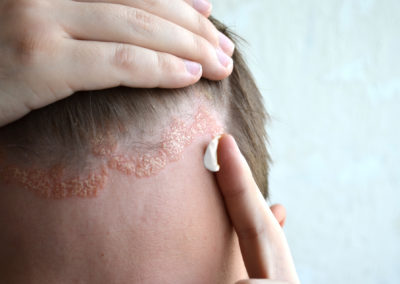Everything you need to know about Psoriasis and Scalp Psoriasis
Psoriasis generally consists of patches of silvery white scale on inflamed red skin and can affect skin on any part of the body. Skin can bleed easily when the scales are removed or disturbed.
The three main features of psoriasis are the shape, colour and the scales. Firstly, a small oval patch appears that remains circular until its size increases to about 5 cm in diameter if this patch continues to enlarge the shape becomes irregular. The inflamed area is usually uniformed colour which can vary from deep red to brown or even purple.
Dry thin scales are always present but the extent of the scaling may vary. The scales remain together in layers on the skins surface and are not easily removed. The scales can be so dense that sometimes the redness of the skin is only apparent when the scales are removed. Removal of the scales can easily make the skin bleed and patches can occur in the crease behind the ears or even in the ears.
Psoriasis can fluctuate on a daily basis.
It can be really bad one day and the next a lot better. Hair loss can occur where the erythema is bad and sometimes a patch of baldness can occur similar to patches of baldness associated with discoid lupus erythematous. It is not normally itchy.
There is a type called guttate psoriasis which has pin head sized flat papules which appear like drops of water on the skin. Streptococcal infection is a major precipitating factor in this type.
Fingernails can also have a pitting or pinprick holes and can appear to have a brown tint or be separated.



